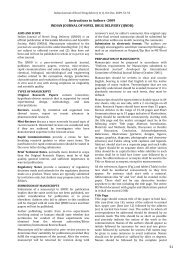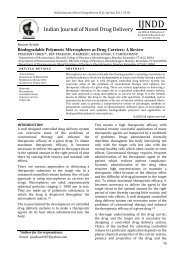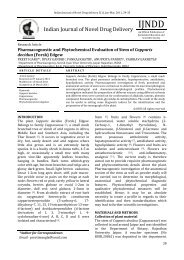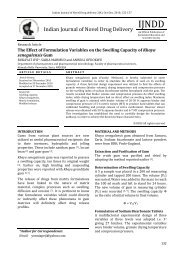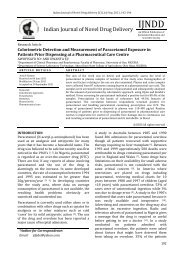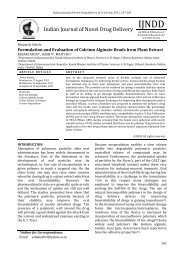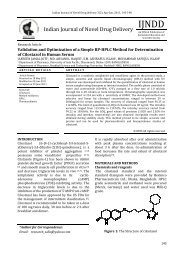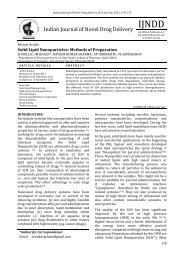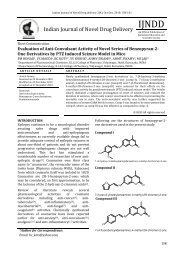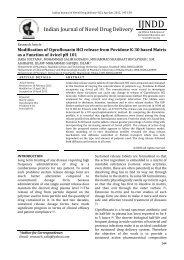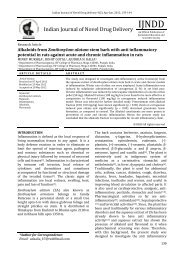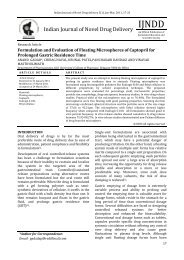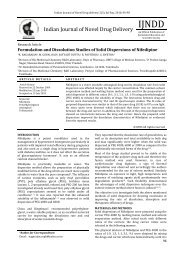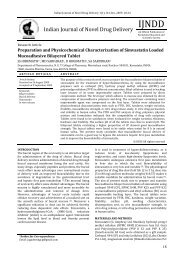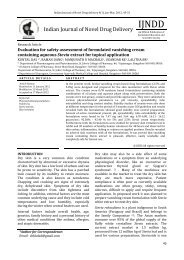Evaluation of Antioxidant Properties of Flower Heads of ...
Evaluation of Antioxidant Properties of Flower Heads of ...
Evaluation of Antioxidant Properties of Flower Heads of ...
You also want an ePaper? Increase the reach of your titles
YUMPU automatically turns print PDFs into web optimized ePapers that Google loves.
Bafna Anand et al / Indian Journal <strong>of</strong> Novel Drug Delivery 3(2), Apr-Jun, 2011, 118-124<br />
It was observed during present evaluation <strong>of</strong><br />
antioxidant activity that CMF had 5-6 times more<br />
scavenging activity than ME. Results <strong>of</strong><br />
preliminary phytochemical work indicated that<br />
CMF constituted 61% <strong>of</strong> ME, rest were non polar<br />
components extracted with petroleum ether,<br />
benzene and chlor<strong>of</strong>orm. All these fractions <strong>of</strong><br />
ME were ineffective in scavenging free radicals<br />
(results not included). Therefore, it can be<br />
considered that free radical scavenging activity<br />
<strong>of</strong> ME was due to CMF only. Phytochemical<br />
reports on S.indicus flowerheads revealed<br />
presence <strong>of</strong> alkaloids [21] , eudesmanolides and<br />
sesquiterpenoids [22, 23] . The exact mechanism <strong>of</strong><br />
action, however, could only be unfolded after<br />
detailed characterization <strong>of</strong> active moieties from<br />
different fractions. Studies on these lines have<br />
already been taken up and shall follow in our<br />
future communications.<br />
CONCLUSIONS<br />
The results <strong>of</strong> present study indicate that<br />
flowerheads <strong>of</strong> S.indicus carry certain levels <strong>of</strong><br />
antioxidant activities. ME and CMF both were<br />
effective in scavenging stable free radical DPPH,<br />
superoxide ion and possess good reducing power<br />
with inhibitory action on lipid peroxidation. The<br />
activity was however <strong>of</strong> moderate nature when<br />
compared to different standard antioxidants.<br />
Further in-vivo studies on evaluation <strong>of</strong> drug are<br />
warranted and already taken up .It may be<br />
concluded that the free radical scavenging<br />
activity <strong>of</strong> flower-heads <strong>of</strong> S.indicus may follow<br />
one <strong>of</strong> the above mechanisms in exhibiting its<br />
effectiveness in traditional medicine.<br />
REFERENCES<br />
[1] Richards RT, Sharma HM. Free radicals in<br />
health and disease. Ind J Clin Pract. 1991; 2<br />
(7): 15-26.<br />
[2] Glaser J L. Maharishi Ayurveda: An<br />
introduction to recent research. Mod Sci<br />
and Ved Sci. 1988; 2(1), 89-108.<br />
[3] Singh RH. Rasayana and Vajikarana In:<br />
Sharma PV, ed. History <strong>of</strong> Medicine in India.<br />
Indian National Science Academy. New<br />
Delhi, 1992.<br />
[4] Sharma HM, Hanna AN, Kauffman EM,<br />
Newman HAI. Inhibition <strong>of</strong> human low<br />
density lipo-protein oxidation in vitro by<br />
Maharishi Ayurveda herbal mixtures.<br />
Pharmacol Biochem and Behav. 1992; 43:<br />
1175-1182.<br />
[5] Sharma PV. Translation: Charka Samhita,<br />
Chikitsothana. 1 st edition, Varanasi<br />
Chaukhambha Orientalia, 1981. P.<br />
[6] Scartezzini P, Speroni E. Review on some<br />
plants <strong>of</strong> Indian traditional medicine with<br />
antioxidant activity. J Ethnopharmacol.<br />
2000; 71: 23-43<br />
[7] Nadkarni KM. Indian Materia Medica, 3 rd<br />
edition, Popular Prakashan, 1976. Vol.3, p<br />
1163.<br />
[8] Vani T, Rajani M, Sarkar S, Shishoo CJ.<br />
<strong>Antioxidant</strong> properties <strong>of</strong> the Ayurvedic<br />
formulation Triphala and its constituents.<br />
Int J Pharmacog. 1997; 35(5): 313-317<br />
[9] Beuchamp C, Fridovich I. Superoxide<br />
dismutase: Improved assays and assay<br />
applicable to acrylamide gels. Anal<br />
Biochem. 1971; 44: 276-277.<br />
[10] Oyaizu M. Studies on product <strong>of</strong> browning<br />
reaction prepared from glucose amine. Jpn<br />
J Nutr. 1986; 44: 307-315<br />
[11] Slater TF, Sawyer BC. The stimulatory<br />
effects <strong>of</strong> carbon tetrachloride and other<br />
halosenoalkanes on peroxidative reactions<br />
in rat liver fractions in vitro. Bin-Item. J.<br />
1971; 123:805-814.<br />
[12] Repetto MG, Llesuy SF. <strong>Antioxidant</strong><br />
properties <strong>of</strong> natural compounds used in<br />
popular medicine for gastric ulcer. Braz J<br />
Med Biol Res. 2002; 35(5): 523-534.<br />
[13] Soares JR, Dinis TCP, Cunha, A P, Ameida,<br />
LM. <strong>Antioxidant</strong> activity <strong>of</strong> some extracts <strong>of</strong><br />
Thymus zygis. Free Rad. Res. 1997; 26:<br />
469-478.<br />
[14] Duh PD, Tu YY, Yen GC. <strong>Antioxidant</strong> activity<br />
<strong>of</strong> water extract <strong>of</strong> harng jyur (<br />
Chrysanthemum morifolium Ramat).<br />
Lebensm.-Wiss.u-Technol. 1999; 32: 269-<br />
277.<br />
[15] Halliwell B, Gutteridge JMC. In: Free<br />
radicals, ageing and disease. Free radicals<br />
in Biology and Medicine, 2 nd edition,<br />
Oxford, Clarendron press, 1985. P. 279-<br />
315.<br />
[16] Shimazaki H. <strong>Antioxidant</strong>s. In: Free radicals<br />
and biological defense, Niki E, Shimazaki, H,<br />
Mino, M (eds), Japanese Science Societies<br />
Press. Tokyo. 1994. p. 45-57.<br />
[17] Machlin LJ, Bendich A. Free radical tissue<br />
damage: Protective role <strong>of</strong> antioxidant<br />
nutrients. FASEB J. 1987; 1: 441-445.<br />
[18] Lin JM, Lin CC, Chen MF. Scavenging effects<br />
<strong>of</strong> Mallotus repandus on active oxygen<br />
species. J Ethnopharmacol. 1995; 46:175-<br />
181<br />
123



